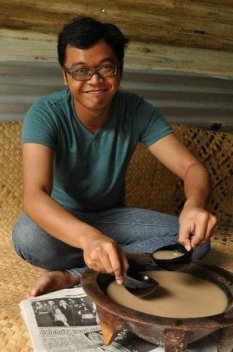A Royal Indian Wedding
By Kurt Zion V. Pala

I had only been two weeks into my first missionary assignment here in Fiji when I witnessed an Indian wedding for the first time. Fiji is multicultural society – the population is composed of ethnic Fijians, Indo-Fijians, Chinese and others. Most of the Indo-Fijians are descendants of the girmitiyas, indentured laborers from India who came to work in the sugar fields of Fiji more than a hundred years ago. Within the Indian population here in Fiji, one can also find diversity in ethnicity and religion. Their ancestors came from different parts of India. There are three major religions practiced by the Indo-Fijians namely Hinduism, Islam and Christianity. Christians in Fiji comprise many groups, mainly Methodist, Catholic and Pentecostal.
Marriages between members of different ethnic groups are not common. On 30 April 30 I had the privilege of witnessing the wedding of an Indian couple, the bride a Catholic and the groom a Hindu. The ceremony lasted about two hours and was filled with many rituals, symbols, colors and scents. I realized through the process of enculturation that the wedding ceremony had been enriched and enlivened. The ceremony happened under a brightly decorated tent called a ‘mandap’ in Hindi on a stage.
We arrived early before everyone started coming to the venue of the wedding, the rented hall of an Indian college. The ceremony began with the sounds of the drums and cymbals announcing the arrival of the groom. The groom was welcomed and given some food and drink; then he was seated. The bride came in and the priest welcomed the couple. Both the bride and the groom looked very royal and beautiful. The priest, together with the parents of the bride and groom, then lit the diya, a camphor lamp used in religious ceremonies.
Everyone settled down and the opening prayer was said followed by the reading of the Gospel and psalms. A bhajan (religious hymn) was sung before the reading of the Gospel.
It was great to be able to witness everything up close since I was also busy taking pictures. The actual wedding rites began with the declaration of the couple’s intention and freedom to marry followed by the kanyadaan where, following Indian culture, the bride was handed over by her parents to the groom. It is a beautiful ritual that shows the value that Indian culture places on women. After this ritual, the couple circled the tent housing the altar seven times. The priest also placed incense in front of the Cross and questioned the couple on a different aspect of married life each time they completed a circle. This ritual is called the bhavar.
At the end of the bhavar, the couple exchanged marriage vows holding each other’s right hand (The left hand is considered unclean in Indian culture). The priest blessed the rings and the couple placed the ring on each other’s finger. The groom tied the tali, a yellow string, around the bride’s neck. Interestingly, the groom’s sister then placed a toe ring on the bride’s right foot, which is a South Indian practice.
Then the bride led the exchange of mala, a garland of flowers, three times. The exchange signifies that whatever one owns, the other also owns. The couple then exchanged seating places. As they were seated, the relatives tied strings of gold metal on the foreheads of the couple. After everyone had their chance, the groom took red dye with his finger and marked a spot, called the tika, on the bride’s forehead between her eyebrows, which is. The tika is a mark that signifies to others that the woman is married. Indians, especially from the Indian South, culturally practice this.
The priest then officially blessed the newly married couple. Finally, relatives and close friends were then invited to approach the married couple and shower them with flower petals mixed with rice grains to bless them. This ritual is called the pushpavrishti. A feast of curry and roti followed, which I had been looking forward to. All kinds of curry were served but without meat to respect the many Hindus who don’t eat meat, especially during religious functions. I loved the sweets and the paisam, made of milk and peanuts. This is one thing common thing to Indians and Filipinos, we love food!
Columban Fr Pat Colgan officiated at the wedding assisted by Master David Krishna who is also my Hindi guru-jii (‘respected teacher’). Fr Pat and the couple went through a lot of preparation before the wedding. Only a few couples ask for this kind of wedding because of the preparations and the complexity of the rituals.
There were many things I found quite different from my experience of weddings in the Philippines. The rituals that provided so much symbolism and meaning were new to me. I think it is important to observe all these rituals and symbolism because they provide the experiential element of the ceremony, which is important in our understanding of the sacraments. I’m sad that we in the Philippines have lost so much of our rituals and symbolisms. We have given in to the commercialism and Westernization of our faith and culture. I admired the Indo-Fijian couple for their courage in remaining faithful to their tradition and thank them for their invitation. It was truly a royal Indian wedding.
You may email the author at kurtzion@yahoo.com or find him on Facebook.
